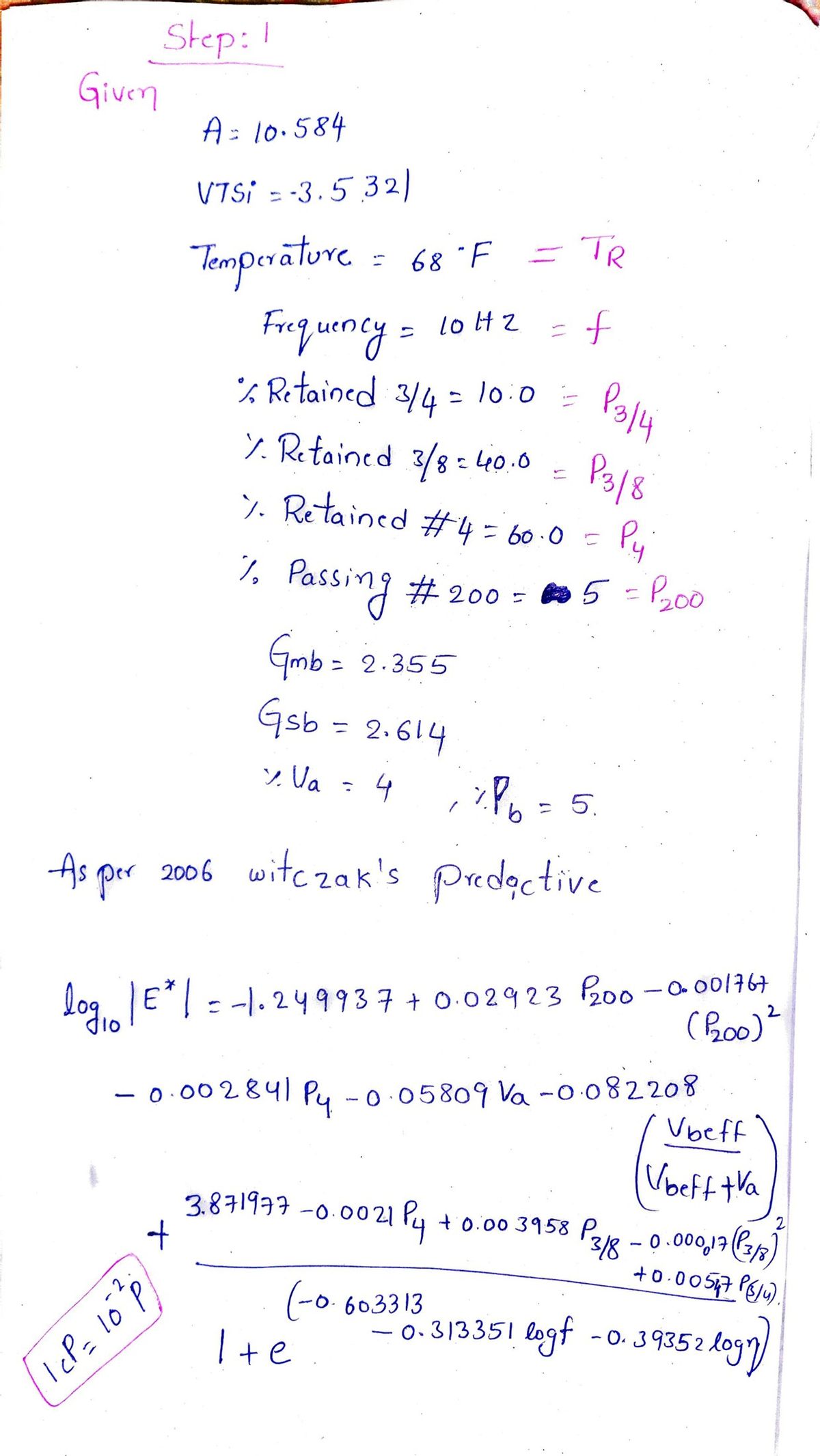pavement
Chapter2: Loads On Structures
Section: Chapter Questions
Problem 1P
Related questions
Question
pavement

Transcribed Image Text:4. Estimate the E* values using Witczak's predictive model (E*| in psi) using the following
data:
Ai
= 10.584
• VTSI
• Temperature, F
• Frequency, Hz
=-3.5321
= 68
= 10
= 10.0
% Retained 3/4
% Retained 3/8
% Retained #4
• % passing # 200
• Guk
• G
% Ya
= 40.0
= 60.0
= 5.0
= 2.355
= 2.614
= 4.0
% P.
= 5.0
5. Based on the knowledge you have received in the pavement design course so far, estimate the
thickness of the AC layer for the below pavement structure to control the initiation of the
bottom up fatigue cracking for perpetual pavement design case knowing that:
• 50 year ESAL = 500 million repetitions
· Axle load is 18,0001b with two sets of dual tires
• Dual tire spacing (center to center) is 12 inches
• Tire pressure is 120 psi
• Considering a sustainable perpetual pavement practice, design a 50-year perpetual
pavement using endurance limit values presented by the NCHRP 9-44A project
12 in.
18,000 lb
AC Layer, E, - 500,000 psi, µ, - 0.35, h, - ????
Base Layer, E, = 50,000 psi, µ; = 0.40, h; = 8 in.
Subgrade Layer, Eso = 10,000 psi, pso = 0.50, lso = 0

Transcribed Image Text:3. The table below includes the coefficients of both the dynamic modulus (E*) sigmoidal
function and the shift factor-temperature function. Determine the LE*| at the mid of the
asphalt concrete layer of the pavement structure given in Question 2 for the following two
conditions:
a. The pavement temperature at the mid of asphalt layer is 50 °F and the traffic speed is 70
mph.
b. The pavement temperature at the mid of asphalt layer is 100 °F and the traffic speed is 30
mph.
c. Discuss the results
a
b
4.810
1.731
0.557
0.628
0.00015
-0.101
6.316
* Note that the |E* units in the sigmoidal function is in psi and the temperature unit in the shift
factor equation is in °F.
Expert Solution
Step 1

Step by step
Solved in 4 steps with 4 images

Knowledge Booster
Learn more about
Need a deep-dive on the concept behind this application? Look no further. Learn more about this topic, civil-engineering and related others by exploring similar questions and additional content below.Recommended textbooks for you


Structural Analysis (10th Edition)
Civil Engineering
ISBN:
9780134610672
Author:
Russell C. Hibbeler
Publisher:
PEARSON

Principles of Foundation Engineering (MindTap Cou…
Civil Engineering
ISBN:
9781337705028
Author:
Braja M. Das, Nagaratnam Sivakugan
Publisher:
Cengage Learning


Structural Analysis (10th Edition)
Civil Engineering
ISBN:
9780134610672
Author:
Russell C. Hibbeler
Publisher:
PEARSON

Principles of Foundation Engineering (MindTap Cou…
Civil Engineering
ISBN:
9781337705028
Author:
Braja M. Das, Nagaratnam Sivakugan
Publisher:
Cengage Learning

Fundamentals of Structural Analysis
Civil Engineering
ISBN:
9780073398006
Author:
Kenneth M. Leet Emeritus, Chia-Ming Uang, Joel Lanning
Publisher:
McGraw-Hill Education


Traffic and Highway Engineering
Civil Engineering
ISBN:
9781305156241
Author:
Garber, Nicholas J.
Publisher:
Cengage Learning